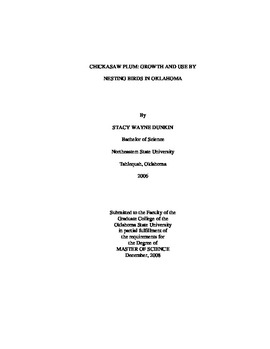| dc.contributor.advisor | Guthery, Fred S. | |
| dc.contributor.author | Dunkin, Stacy Wayne | |
| dc.date.accessioned | 2014-04-15T21:59:41Z | |
| dc.date.available | 2014-04-15T21:59:41Z | |
| dc.date.issued | 2008-12-01 | |
| dc.identifier.uri | https://hdl.handle.net/11244/9166 | |
| dc.description.abstract | Scope and Method of Study: I collected stem and stand data to develop growth models for Chickasaw plum (Prunus angustifolia), stand-area data for comparison of area data measured with a hand held Global Position System (GPS) unit and Graphical Information System (GIS) analysis, bird nest data to describe nesting in Chickasaw plum, and incidental natural history observations on the use of Chickasaw plum by wildlife in 3 Oklahoma counties during 2006-2008. Findings and Conclusions: I sampled Chickasaw plum stands (n = 95) and stems (n = 155) ranging in size from 29-1 774 m2 to develop growth models. Based on zero-intercept regression models, stands grew at similar rates (overlapping 95% CIs) among counties with a pooled estimate of 31.0 m2/yr (95% CI = 26.5-35.6 m2/yr; n = 95). This rate showed considerable variability within and among study sites (r2 = 0.27). Stem diameter increased (zero-intercept models) more rapidly in north-central Oklahoma (5.27 mm/yr; 95% CI = 5.01-5.53 mm/yr; r2 = 0.81; n = 53) than in north-western Oklahoma (3.68 mm/yr; 95% CI = 3.55-3.81 mm/yr; r2 = 0.83; n = 102); data pooled because of similar rates in Ellis and Harper counties). Stem height was a power function of stem age (y = 0.97x0.28; r2 = 0.31), indicating rate of growth in height (m/yr) declined with age according to dy/dx = 0.27x-0.72. In 2006, stand areas estimated with GPS units and GIS analysis were strongly correlated (r2 = 0.92, n = 49). There was substantial variation in annual relative growth (Δarea/beginning area) for stands <400 m2 whereas larger stands had relative growth rates near 0.0. Correlation analysis indicated that if a stand had a low relative growth rate in year t, it tended to compensate with a high relative growth rate in year t +1. I observed 5 and inferred 4 species for a total of 9 species nesting in plum. Nest height was consistent among species at averages ranging from 0.7 0.13 m SE for field sparrows (Spizella pusilla) to 1.1 0.07 m SE for northern mockingbirds (Mimus polyglottos). The results indicated that relatively old (≥10 yr) stands of Chickasaw plums are important components of habitat for this shrub-nesting guild. I observed 6 species of mammals, including domestic livestock, associated with plum. Mammals used plum for thermal and resting cover and to a lesser extent food. Passerines were the most frequent taxon of the 20 species of birds observed using plum for nesting, singing, resting, foraging, and/or escape. I also observed 2 reptile species and 6 invertebrate species using plum. | |
| dc.format | application/pdf | |
| dc.language | en_US | |
| dc.publisher | Oklahoma State University | |
| dc.rights | Copyright is held by the author who has granted the Oklahoma State University Library the non-exclusive right to share this material in its institutional repository. Contact Digital Library Services at lib-dls@okstate.edu or 405-744-9161 for the permission policy on the use, reproduction or distribution of this material. | |
| dc.title | Chickasaw Plum: Growth and use by nesting birds in Oklahoma | |
| dc.type | text | |
| dc.contributor.committeeMember | Bidwell, Terrence G. | |
| dc.contributor.committeeMember | Hallgren, Stephen W. | |
| osu.filename | Dunkin_okstate_0664M_2917.pdf | |
| osu.college | Agricultural Sciences and Natural Resources | |
| osu.accesstype | Open Access | |
| dc.description.department | Department of Natural Resource Ecology and Management | |
| dc.type.genre | Thesis | |
